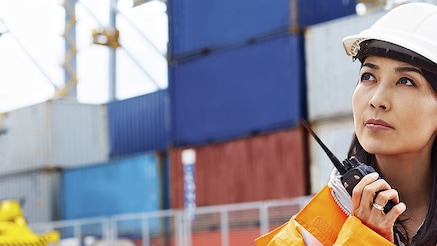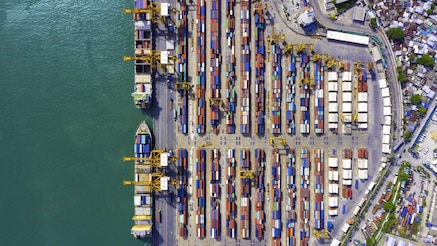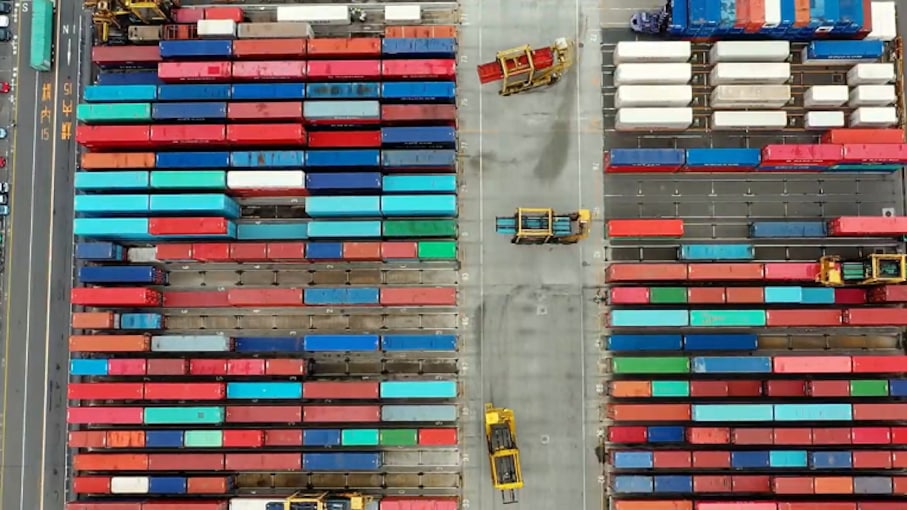Dropping anchor at seaport 4.0

Maritime trade has been the cornerstone of global commerce since time immemorial. An essential component of that are ports where up to 90 percent of the world’s merchandise is loaded and unloaded. Insatiable consumer and industrial demand and economic policies aimed at spurring growth have put the spotlight firmly on seaborne trade, especially port infrastructure.
Today, ports are vital to the international supply chain, handling fossil fuels, raw materials, finished products, livestock, chemical, agricultural and industrial goods. Down the years they have witnessed rapid expansion to cope with ever-increasing freight traffic and the trend is only set to accelerate in future decades.
While ports, both small and big, have received significant investments, operational difficulties are on the rise, making rapid and large-scale modernization imperative. New trade routes, burgeoning vessel traffic, capacity constraints, lack of proper communications connectivity, labour shortage, the need to adhere to stringent environmental norms and a host of other regulations are just a few of the many challenges facing them.
As the world witnesses a tidal wave of emerging technologies, driving Industry 4.0 and transforming businesses, ports have started to explore and integrate a new crop of connectivity and data-enabled systems.
What is Industry 4.0?
Industry 4.0 aims to connect the digital to the physical world. By introducing unprecedented levels of operational process automation, usage of digital applications/services and highly secure and reliable connectivity, it will usher in transformative changes to industrial operations.
Realizing the smart port
Ports have progressively evolved in terms of structure and function, but the next step-up is going to be revolutionary. Digitalization is poised to usher in a generational leap that will change the very way a port sees and operates itself.
The ‘smart’ port will leverage the latest standards of network connectivity, automation, service integration and ground-breaking innovations encompassing the Internet of Things (IoT) artificial intelligence and machine learning (AI/ML), big data, augmented reality (AR), digital twins, blockchain and other data-based techniques.
With dynamically changing volumes of container traffic – that is growing relentlessly each year – staying on top in the competitive container terminal industry means constantly striving for new levels of operational excellence. A digital port will employ real-time information and a 360-degree collaborative approach to optimize terminal, port and shipping operations. Automated systems based on remote controlled, freely ranging container handling equipment will spearhead cargo processing, while enhanced maintenance, safety and security architectures strengthen resiliency.
Sustainability, pivotal to any business operation, will sit at the heart of a smart port. Digitalization will allow the ports to be greener by accelerating decarbonization, cutting harmful emissions, improving air quality and minimizing waste.
“Recent technology developments have opened new horizons for the port industry. The convergence of digital technology and physical assets with information and communications technologies is paving the way for smart ports turning them into futuristic logistical and transport hubs,” says Fai Lam, Director of Transportation Marketing at Nokia.
Key advantages of smart ports
- Superior levels of efficiency
- Increased capacity
- Reduced operating costs
- Real-time data visibility and management
- Predictive maintenance
- Improved safety standards
- Energy savings and low emissions
Everything hinges on connectivity
Digitalization of ports and the varied benefits it would bring has to be underpinned by a robust and all-pervasive wireless and broadband connectivity. A comprehensive portfolio combining private wireless, fixed broadband, IoT and intelligent analytics solutions is critical in that respect.
At this juncture, it’s important to note that LTE/5G networks will be the foundation for advanced automation and digitalization. These new networks are allowing modern ports to be more competitive and prepare for the next age of Industry 4.0 technologies.
For instance, with a private LTE or 5G network, ports would be able to realize true competitive advantage by using the existing ecosystem of machines, sensors and systems. The wireless networks that most ports rely on presently are ill-suited for business-critical industrial use cases or modern terminal operations. They were designed for tasks like web browsing and email communications, and characterized by unpredictable performance, patchy coverage and poor security.
A reliable industrial-grade private wireless network will establish seamless connection between the terminal operating system (TOS), sensors, trucks, cranes, forklifts and cameras. Real-time situational awareness and greater visibility of many moving elements will help enhance safety. It would allow for the deployment of force multipliers like Unmanned Aerial Vehicles (UAVs). Drones could be used to transport equipment, help in surveying infrastructure and keeping the port complex secure by providing live high-definition video feed.
Fast and robust communications from ship to shore is an absolute necessity, especially when it comes to managing traffic. A smart port will have the required assets to ensure that ships are connected through secure wireless communications to land. Capabilities can also be put into place that allow vessels to benefit from bandwidth aggregation and higher levels of quality of service (QoS) and security.
The advent of IoT has come as a boon for industries of all types and the transport and logistics sector is no exception. It represents a convergence of the digital and physical domains that draws value from data. IoT can be employed for a plethora of use cases. Apart from tracking ships and their cargo and the identification of containers, IoT provides precise inputs for informed decision-making, captures data from transport and warehouse management systems, keeps a tab on automated processes, equipment, checks water, temperature, gas and humidity levels. It can play a significant role in perimeter security as well.
The confluence of such complex and exceedingly efficient technologies takes us to an issue of major consequence. A colossal stream of data that gushes out 24/7 from different touchpoints. They need to be harnessed, collated, processed and stored before being used as actionable intelligence. This is where advanced, intelligent analytics systems come in. Powered by AI/ML, they can help with predictive maintenance, asset management, upkeep of records and produce forecast models. The data can take different forms, including text, audio, video and can help port authorities accurately track all that is going on and even pre-empt what is to follow.
Laying the groundwork
Port logistics will be subjected to a seismic shift as smart technologies redefine operations. With ships getting bigger in size, traffic on the upswing and a voracious globalized economy clamouring for the rapid transit of goods, port authorities need to be at the top of their game if they are to remain competitive and at capacity. There are several steps the industry needs to take before reaping the benefits of port 4.0.
“Ports are harsh external environments with a lot of metal that keeps moving dynamically. Any digitalization solution considered for this environment needs to be resilient and sturdy. The solutions that get deployed at a port environment need to flawlessly integrate with the end-to-end solution inside the port and interact with the wider supply chain consisting of other parties,” says Venkatesh Ramakrishnan, Head of Maritime, Logistics and Retail Verticals at Nokia Enterprise.
“We see ports riding the wave of Industry 4.0 with lots of IoT devices and sensors, automated container handling equipment, a variety of applications bringing varied use cases/solutions and finally a strong AI/ML that processes the huge amount of data a port can generate. We believe this would be underpinned with a resilient wireless network such as Private LTE or 5G,” he adds.
All this leads us to believe that the strategic value of a port is no longer reliant on its geographical location or its proximity to industrial heartlands but on how it uses technology to remain efficient and competitive. An argument which, fortunately, is finding resonance within the industry.
Read more:

Industry
Port terminal operations

Industry vertical
Port Terminal Business Case
About Nokia
At Nokia, we create technology that helps the world act together.
As a trusted partner for critical networks, we are committed to innovation and technology leadership across mobile, fixed and cloud networks. We create value with intellectual property and long-term research, led by the award-winning Nokia Bell Labs.
Adhering to high standards of integrity and security, we help build the capabilities needed for a more productive, sustainable and inclusive world.
Media Inquiries:
Nokia
Communications
Email: press.services@nokia.com


